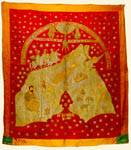|
|
| Church Embroidery |
1627 Simonopetra Monastery 107 x 94 cm |
|

|
Embroidered on red satin, this pyle traces, both in the arched top and in the 'chalice'-shaped bottom, the outline of the Royal Door in the wooden iconostasis for which it is designed: when drawn, only the scene of the Nativity, the feast to which the monastery is dedicated, will be visible. The sanctuary is the star-spangled heaven, represented on the material of this pyle. A rocky landscape, roughly triangular in shape and worked in gold thread, represents the earth, upon which are embroidered the various episodes of the Nativity. The central figure, the Virgin, lies on a pallet and gazes tenderly at the Christ Child, swaddled and lying in a box-shaped manger, while the ox and the ass warm him with their breath. Behind the rocks to the Virgin's left, an angel brings the good tidings to the shepherds, while from around the rocks to her right the three Wise Men appear, arriving in all haste on their galloping steeds. The scene illustrates the kontakion (hymn) embroidered in elegant capitals around the arch: 'This day hath the Virgin borne One that transcends substance, and the earth offers a shelter to the unapproachable. Angels and shepherds sing Gloria, wise men follow the guiding star. For unto us is born a child, the eternal God'. The words are followed by the date ' ΕΤΟΥC X(ΡΙCTO)Y αχκζ΄' (Anno Domini 1627). At the edge of the silk-embroidered triangle Joseph sits pensively, while the devil in the guise of a shepherd appears before him (the temptation of doubt). As the Virgin's affianced husband, he is removed from the scene of the Nativity, signifying that he is not the father of the child. On a ribbon intersecting the dome is embroidered in calligraphic capitals the Christmas apolytikion 'With Thy birth, O Christ our Lord, the light of knowledge dawned in the world'. Above this verse is a segmentum coeli, from which the star that guided the Magi descends. The name of the embroiderer is inscribed under the 'chalice' of the pyle: 'ΘΕΟΥ ΤΟ ΔΩΡΟΝ Κ(ΑΙ) Κ(ΑΛ)ΛΙΝ(Ι)ΚΟΥ ΠΟΝΟC' (The gift of God and the labour of Kallinikos). The embroiderer, or rather his anthivolon, followed the iconography of the Byzantine period, which he adapted to the demands of his age. He observed the rules of perspective and emphasized the figure of the Virgin's position in the scene, rather than by altering the scale. He used both gold and silver thread and a range of coloured silks, including blue, green and grey. The faces are worked in wheat-coloured silk, and the hair in black or brown. This pyle is one of the loveliest known works from the seventeenth century. Brother Kallinikos had also embroidered a pyle for the Koutloumousiou Monastery in 1616-7, with a representation of the 'Prophets from above' (repaired in 1872), which displays a number of similarities with the Simonopetra pyle (see also the 1614 Epitaphios from the Monastery of Docheiariou, by the same craftsman no. 11.21).
| |
|
Bibliography: Theochari 1963, pp. 498-9, pls. Γ΄, Δ΄. Theocharis 1991, pp. 218-9, fig. 144.
| ||
| M. Th. | ||
| Index of exhibits of Monastery of Simonopetra 17th century |
||
Reference address : https://www.elpenor.org/athos/en/e218ck24.asp